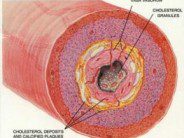Tobacco smoking is an independent risk factor for heart disease and stroke. Smoking causes hardening of the arteries, also termed atherosclerosis, and dysfunction of the endothelial lining of arteries. Second hand smoke has been identified as being similarly detrimental to health. In 2002, New York City as well as other cities throughout the United States put into law a ban on all indoor smoking. In addition, we have previously discussed the recent banning of outdoor smoking in New York City. The indoor smoking ban had initially been met with some resistant, but we are beginning to see that it has had a beneficial effect on the overall health of the American people.
Researchers, led by Dr. Richard D. Hurt of the Mayo Clinic in Rochester, Minnesota have found that the indoor smoking ban has dramatically decreased the rate of heart attack and sudden cardiac death attributable to second hand smoke. The results of their research were published online in the Archives of Internal Medicine. The researchers used the Rochester Epidemiology Project to evaluate the impact of an indoor smoking ban on the incidence of myocardial infarction and sudden cardiac death in Olmsted County. The researchers found that the incidence of heart attack, or myocardial infarct, decreased by 33% after the indoor smoking ban was put into effect. In addition, the incidence of sudden cardiac death decreased by 17%, although this result was not statistically significant there was an overall trend toward this result. These results were obtained even when the rates of other cardiovascular risk factors remained the same or increased. Thus, this finding can be attributed to the decrease in second hand smoke that resulted from the indoor smoking ban.
The authors wrote, “A substantial decline in the incidence of [myocardial infarction] was observed after smoke-free laws were implemented, the magnitude of which is not explained by community cointerventions or changes in cardiovascular risk factors with the exception of smoking prevalence. As trends in other risk factors do not appear explanatory, smoke-free workplace laws seem to be ecologically related to these favorable trends”.
The authors added, “Secondhand smoke exposure should be considered a modifiable risk factor for [myocardial infarction]. All people should avoid secondhand smoke to the extent possible, and people with coronary heart disease should have no exposure to secondhand smoke”.
In an accompanying editorial it was commented, “As more areas adopt smoke-free legislation, the evidence base documenting the positive health outcomes resulting from such measures continues to grow. Moving forward, we should prioritize the enforcement of smoke-free policies, eliminating loopholes in existing policies as well as encouraging expansion of smoke-free policies to include multiunit housing, motor vehicles, casinos, and outdoor locations”.
This study provides evidence that the decrease in second hand smoke that has resulted from the indoor smoking ban has been beneficial for health. Only about half of the states in the United States have a ban on indoor smoking. The results of this study, as well as some previous studies, should influence the extension of the indoor smoking ban to all of the states. Future studies should evaluate the impact of the indoor smoking ban on other smoking related illnesses such as asthma, chronic bronchitis, and emphysema.
See the YouTube video wtih Dr. Richard Hurt entitled “Smoke Free Workplaces Lead to Reduction in Cardiac Events”:
References:
Richard D. Hurt et al. “Myocardial Infarction and Sudden Cardiac Olmsted County, Minnesota, Before and After Smoke-Free Workplace Laws” Arch Intern Med. 2012; ():1-7. doi:10.1001/2013.jamainternmed.46.
Sara Kalkohoran and Pamela M. Ling “Extending the Health Benefits of Clean Indoor Air Policies” Arch Intern Med. 2012; ():1-2. doi:10.1001/2013.jamainternmed.269










 DrSamGirgis.com is a blog about medicine, nutrition, health, wellness, and breaking medical news. At DrSamGirgis.com, the goal is to provide a forum for discussion on health and wellness topics and to provide the latest medical research findings and breaking medical news commentary.
DrSamGirgis.com is a blog about medicine, nutrition, health, wellness, and breaking medical news. At DrSamGirgis.com, the goal is to provide a forum for discussion on health and wellness topics and to provide the latest medical research findings and breaking medical news commentary.
{ 2 comments… read them below or add one }
I agree completely with the indoor smoking ban, and here is the proof that the health of all of us is going to benefit as a result.
Now, how do we get smokers to completely quit?
In order to quit smoking, the desire needs to come from within, but there are social and medical therapies that can help.